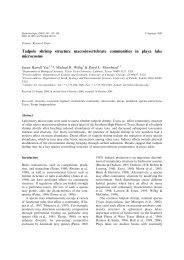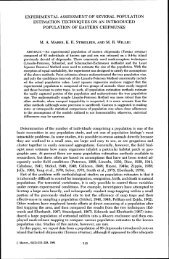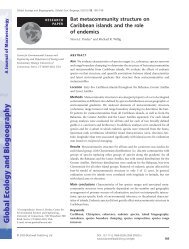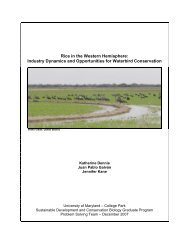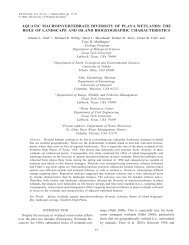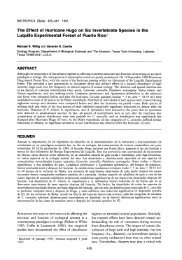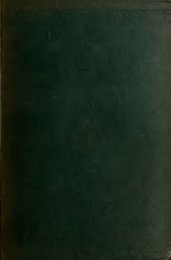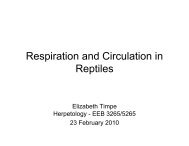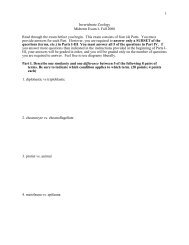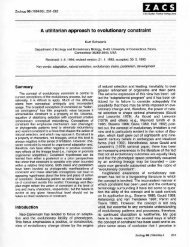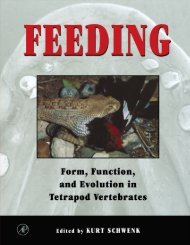Journal of Tropical Ecology (2006) - USDA Forest Service
Journal of Tropical Ecology (2006) - USDA Forest Service
Journal of Tropical Ecology (2006) - USDA Forest Service
You also want an ePaper? Increase the reach of your titles
YUMPU automatically turns print PDFs into web optimized ePapers that Google loves.
112 CHRISTOPHER P. BLOCH AND MICHAEL R. WILLIG<br />
taxonomically well-known and numerically abundant, as<br />
well as ecologically important, particularly with respect<br />
to nutrient cycling (Jennings & Barkham 1979, Jones &<br />
Shachak 1990, Theenhaus & Scheu 1996). In addition,<br />
gastropods are ectotherms, are susceptible to desiccation,<br />
and are not very vagile; consequently, they may be<br />
affected strongly by disturbance and its <strong>of</strong>ten substantial<br />
modification <strong>of</strong> microclimate. Despite the clear ecological<br />
importance <strong>of</strong> terrestrial gastropods, little is known about<br />
the ecology <strong>of</strong> most species. Moreover, relatively few<br />
studies directly examine the responses <strong>of</strong> terrestrial snails<br />
to natural disturbance (but see Alvarez & Willig 1993,<br />
Karlin 1961, Secrest et al. 1996, Strayer et al. 1986,<br />
Willig & Camilo 1991, Willig et al. 1998). Most studies<br />
<strong>of</strong> the effects <strong>of</strong> disturbance on animal populations<br />
have focused instead on insects or vertebrates (Willig &<br />
McGinley 1999).<br />
Although terrestrial gastropods respond to disturbance<br />
in a species-specific manner (Secrest et al. 1996, Willig &<br />
Camilo 1991, Willig et al. 1998), a few basic predictions<br />
are possible based on the biological characteristics <strong>of</strong> the<br />
group. The microclimate <strong>of</strong> canopy gaps is characterized<br />
by increased soil and air temperatures, enhanced rates <strong>of</strong><br />
evaporation, and decreased relative humidity compared<br />
with undisturbed forest (Denslow 1980, Fernandez &<br />
Fetcher 1991). The degree <strong>of</strong> microclimatic difference<br />
between disturbed and intact forest increases with the<br />
size <strong>of</strong> the gap (Lee 1978). Hot, dry conditions, such as<br />
those found in gaps, <strong>of</strong>ten affect gastropods negatively<br />
(Cook 2001, Russell-Hunter 1983). Indeed, desiccation<br />
may be the primary cause <strong>of</strong> snail mortality (Solem 1984).<br />
Eggs and early growth stages are particularly vulnerable<br />
to elevated temperatures and reduced humidity (Baur &<br />
Baur 1993, Heatwole & Heatwole 1978, Riddle 1983).<br />
Thus, hurricanes, which generate large, widespread<br />
openings in the forest canopy, should decrease population<br />
densities <strong>of</strong> terrestrial gastropods, perhaps even<br />
extirpating less abundant species from some localities.<br />
Conversely, some species (especially those most tolerant<br />
to desiccation) may benefit from conditions generated<br />
by disturbance, either by exploiting a new or increased<br />
resource base or enjoying reduced rates <strong>of</strong> predation or<br />
competition. This may be particularly true <strong>of</strong> species<br />
thathaveevolvedindisturbance-mediatedenvironments,<br />
such as the Caribbean Basin.<br />
Hurricanes produce a mosaic <strong>of</strong> environmental conditions<br />
that become less disparate over time as canopy<br />
gaps close. If the effect <strong>of</strong> hurricanes on terrestrial gastropods<br />
is primarily indirect through changes in microclimate,<br />
then population densities <strong>of</strong> snails should mirror<br />
the mosaic pattern <strong>of</strong> disturbance intensity; densities will<br />
remain relatively unaffected in undisturbed refugia and<br />
be reduced severely in the most disturbed locations. Unless<br />
disturbance is so intense as to devastate a population<br />
throughout its geographic range, variance in density<br />
should be highest after recent disturbance and decline<br />
thereafter as the canopy regenerates, microclimatic<br />
conditions become more uniform, and snail densities and<br />
distributions become less restricted by desiccation. Rare<br />
or hypodispersed species may be an exception. Reduction<br />
<strong>of</strong> their densities by disturbance may result in increased<br />
homogeneity simply because they will not be locally<br />
abundant anywhere, or because they decline at one or<br />
more <strong>of</strong> the sites where abundance is high.<br />
In the last 20 y, two major hurricanes (Hugo in 1989<br />
and Georges in 1998) have struck the island <strong>of</strong> Puerto<br />
Rico.Thetwohurricanesdifferedinintensityandseverity,<br />
with Hurricane Hugo producing larger canopy openings<br />
and depositing more debris than did Hurricane Georges<br />
(Lugo & Frangi 2003, Ostertag et al. 2003). Additionally,<br />
the historical context <strong>of</strong> the two storms differed. Hurricane<br />
Hugo was the first major hurricane to make landfall<br />
in north-eastern Puerto Rico in over 30 y (Scatena &<br />
Larsen 1991, Turner et al. 1997), whereas Hurricane<br />
Georges arrived only 9 y after Hurricane Hugo. This study<br />
evaluated long-term population-level trends <strong>of</strong> terrestrial<br />
gastropods, to determine whether species respond to<br />
hurricane disturbances in a consistent fashion, or<br />
whether differences in hurricane intensity or disturbance<br />
history result in disparate population-level responses.<br />
METHODS<br />
Study site and field methodology<br />
The Luquillo Experimental <strong>Forest</strong> (LEF) is an 11 330-ha<br />
tract <strong>of</strong> land located in the Luquillo Mountains <strong>of</strong> northeastern<br />
Puerto Rico. It ranges in elevation from 100<br />
to 1075 m and encompasses four distinct forest types:<br />
tabonuco, palo colorado, dwarf, and palm forests (Brown<br />
et al. 1983). Of these, the tabonuco forest, which is the<br />
mostextensivelystudied(Odum&Pigeon1970,Reagan&<br />
Waide 1996), is the setting for this research. This forest<br />
type occurs below 600 m and takes its name from the<br />
dominant tree, tabonuco (Dacryodes excelsa). The climate<br />
is typical <strong>of</strong> tropical forests. Rainfall is substantial (245–<br />
400 cm y –1 , depending on elevation; Brown et al. 1983),<br />
with the driest months being January through April.<br />
Relatively little seasonal or diurnal variation occurs in<br />
temperature (Odum et al. 1970).<br />
Long-term censuses <strong>of</strong> terrestrial gastropods were<br />
undertaken on the Luquillo <strong>Forest</strong> Dynamics Plot (LFDP),<br />
a 16-ha grid near El Verde Field Station, in the north-west<br />
<strong>of</strong>theLEF(18 ◦ 10 ′ N,65 ◦ 30 ′ W).Circularplots(3 mradius)<br />
were established at 40 points on the LFDP in 1991 (Willig<br />
et al. 1998). Plots were spaced evenly such that 60 m<br />
separated adjacent points along a row or column within<br />
a rectilinear grid. From 1991 to 2004, gastropod surveys<br />
were conducted twice annually to account for seasonal



